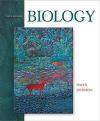 |  Biology, 6/e Author Dr. George B. Johnson,
Washington University
Author Dr. Peter H. Raven,
Missouri Botanical Gardens & Washington University
Contributor Dr. Susan Singer,
Carleton College
Contributor Dr. Jonathan Losos,
Washington University
The Noncoelomate Animals
Answers to Review Questions|
Chapter 44 (p. 898)
1. Animals are multicellular heterotrophs that digest their food internally. This distinguishes them from the other kingdoms of living organisms.
2. The two animal subkingdoms are Parazoa, which are asymmetrical and have no tissues or organs, and Eumetazoa, which are symmetrical and have tissues organized into organs and organ systems.
3. Sponges evolved from the choanoflagellate protists, as evidenced by the presence of choanoflagellate-like cells (choanocytes) in the body of the sponge.
4. In a sponge, food particle stick to microfibrils connecting collar strands, which serve as a food sieve.
5. The primary stages in sponge reproduction are as follows: gametes are shed into the water for external fertilization; initial development occurs within the body of the adult; when released, the larvae have many external flagellated choanocytes that are free-swimming.
6. A planula is a free-swimming, multicellular, ciliated cnidarian larva derived from fusion of gametes.
7. Platyhelminthes' body plan is acoelomate. They are dorsoventrally flattened and have a distinct head at the anterior end. Most are parasitic, although some are free-living. They move through ciliated epithelial cells on their ventral surface. The digestive system is with the gut branched, with only one opening.
8. Flukes possess a digestive tract; tapeworms do not. Tapeworms absorb their nutrients directly over the body wall. The tapeworm is composed of a head provided with suckers, hooks, or both, a neck region, and an extended region of repeating segments, which become reproductively active with distance from the head. These segments can release gametes and become detached and pass out with the feces of the host organism.
9. The nematodes are structurally unique because they completely lack cilia and flagella, even in the sperm and excretory organs.
10. Rotifers are pseudocoelomate aquatic animals that use a crown of cilia to sweep particulate food materials into a muscular grinding area.
11. Myzostomids are most closely allied with annelids.
|
|



 2002 McGraw-Hill Higher Education
2002 McGraw-Hill Higher Education